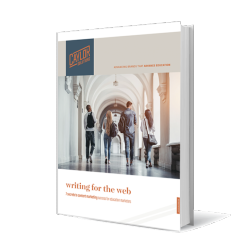Crisis Communication in Higher Ed: Pepperdine’s Wildfire Response
See how Pepperdine University redefined crisis communication in higher ed by prioritizing safety, faith, and storytelling during the California wildfires.
Featured
Higher ed in general—and we marketers in particular—are due for a wholesale change in how we think and use the latest generative AI technology.
Overall, people in higher ed are anxious about the potential upheaval AI will bring to the classroom.
They have legitimate concerns about the potential abuse of ChatGPT and other AI tools by students in their academic studies.
According to this article, teachers fear that with generative AI, students could sit back and let ChatGPT do all the work! Cheating could truly blossom in the 21st century.
Also, when creating academic content, generative AI produces text that is often false or outdated.
Unfortunately, the concern over plagiarism or academic mediocrity is creeping into conversations around marketing.
Will using generative AI tools wipe out all originality and authenticity from our marketing content?
With all the voices out there warning us about the potential dangers of generative AI, should we hold back from using it in our marketing content and daily work?
Absolutely not. The answer to the fears is exactly the opposite.
As higher ed marketers, we should be the first ones to implement generative AI in our workflows and lead the pack in adopting this new technology ethically and effectively.
The advent of ChatGPT and other AI platforms is not the first time an industry has been upended by a new technology.
Each time this has happened, we as a human race have the same conversation.
In this Saturday Evening Post article from 1930, automobile pioneer Alexander Winton writes that he was considered an “imbecile” for thinking his “fool contraption… will ever displace the horse.”
In the article, Winton quotes Thomas Edison, who was a contemporary, about how the horseless carriage would soon replace the horse carriage industry.
“Talking of horseless carriage suggests to my mind that the horse is doomed. The bicycle, which, 10 years ago, was a curiosity, is now a necessity. It is found everywhere… The money spent in the keep of the horses will be saved and the danger to life will be much reduced.
It is only a question of a short time when the carriages and trucks of every large city will be run by motors. The expense of keeping and feeding horses in a great city like New York is very heavy, and all this will be done away with.”
You can hear the finality in his statement. Many jobs, from blacksmiths to street cleaners would “be done away with.”
Many people, in marketing and in academia, are worried that generative AI is going to do away with many jobs within our industry.
Right now, one concern is that generative AI will harm our ability to think.
Instead of thinking through an essay, for example, we’ll just go to ChatGPT and let it think for us.
But this isn’t the first concern expressed over how new technology could harm humans.
When trains first came out, it was thought that they would drive people insane.
As the railway grew more popular in the 1850s and 1860s, trains allowed travelers to move about with unprecedented speed and efficiency, cutting the length of travel time drastically. But according to the more fearful Victorians, these technological achievements came at the considerable cost of mental health. As Edwin Fuller Torrey and Judy Miller wrote in The Invisible Plague: The Rise of Mental Illness from 1750 to the Present, trains were believed to “injure the brain.” In particular, the jarring motion of the train was alleged to unhinge the mind and either drive sane people mad or trigger violent outbursts from a latent “lunatic.” Mixed with the noise of the train car, it could, it was believed, shatter nerves.
We know now that trains do not cause insanity. But at the time, boarding a train seemed a scary risk.
Of course, these fears over automobiles and trains look ridiculous today.
Back then, however, those fears were very real.
People thought the new technology was a threat.
But we shouldn’t look at generative AI as a threat. Instead, we should approach it as a tool.
All technology is a tool. Sure, it can cause harm, as any tool can.
But when used properly, it serves to advance our economy and the quality of life of everyone.
In that earlier quote from Thomas Edison, he said this about the advent of automobiles.
“You must remember that every invention of this kind which is made adds to the general wealth by introducing a new system of greater economy of force. A great invention which facilitates commerce, enriches a country just as much as the discovery of vast hoards of gold.”
Great inventions introduce new systems of “greater economy of force.”
That implies that we’re going to see a lot of changes in the future, but they will end up being good changes, if we learn how to adapt to them.
In past blog posts, I’ve written about the short order cook mentality that sometimes plagues education marketers.
This is the danger that many marketing teams fall into when the executives and other departments begin treating them like creative “order takers.”
“Design a new email. Change this copy. Enhance this landing page. Write me a new social media post.”
The list of marketing tasks never ends!
That is what this article in The Chronicle of Higher Education, calls a “copy shop” mentality.
One big reason it’s hard for college marketers to make headway with the people and resources they already have is what they refer to as the “copy shop” mentality. They are forever being asked to come up with text for this release or that post, or to make improvements to this flier or that slide deck, which often leaves little time for strategic work that can have more substantive effect on institutional priorities.
But generative AI can be the short order cook you need desperately so that you can move on to the more strategic work!
In the same article, the writer kindly featured my thoughts on the subject of how AI can help marketers push through busy work more efficiently. I like to use a superhero analogy.
“It’s kind of like Tony Stark climbing into the Iron Man suit. He is still Tony Stark, but the Iron Man suit allows him to have these amazing powers that amplify what he can already do.”
For Tony Stark, the Iron Man suit wasn’t a replacement, it was a tool he created and used to get the job done better.
If you think about it, refusing to adapt to the changes is simply not an option. Consider the following illustration.

Artwork by Bart Caylor via MidJourney
If your contractor insisted on using only hand tools to build your home, would you question their ability?
Imagine a lone man showing up to build your home, holding just a hammer.
You suggest that perhaps there are better tools available that should be used. Your neighbor’s house went up in record time and under budget with the use of automatic nailers.
You are quickly dismissed.
“My hammer is just fine. Thank you.”
“I have always done it this way. I am not about to change for some newfangled way of doing things.”
“Those automatic nailers are just wrong.”
I’m sure you wouldn’t keep that contractor working on your house for very long.
By insisting on using the old tool exclusively, the project would run way overschedule and way over budget.
No one would pay more to get slower service when they can get the same or better quality faster and cheaper.
I have been hearing a lot of people talk about using AI tools in the same way as the fictional contractor in my illustration.
As if using an AI tool is somehow tantamount to cheating or creating something inauthentic.
“Our team doesn’t need any new ways of doing things. We are fine. Thank you.”
“It won’t work for us; I have tried it.”
“ChatGPT is just wrong.”
But you know what? You’re not a better writer if you draft it longhand rather than using a computer.
Nor are you a better marketer to avoid learning how to use the new tools.
Using a tool is not cheating or being inauthentic.
It is working smarter, not harder.
We have to get our heads around the fact that these are tools and not threats.
For more helpful insights into leveraging generative AI in your marketing workflow, register here to receive your Digital Pass to all of the recordings and resources from The Higher Ed Marketer AI Summit!
Then you’ve got to know how to write for the web. That’s why we want to send you our popular ebook: Writing for the Web: 7 Secrets to Content Marketing Success for Education Marketers!
With this helpful resource, you’ll learn how to:
In short, you’ll be able to write the copy that makes your digital marketing strategy work for you. Download your copy today!
Featured image by Bart Caylor with Midjourney.com
Subscribe to The Higher Ed Marketer podcast today!